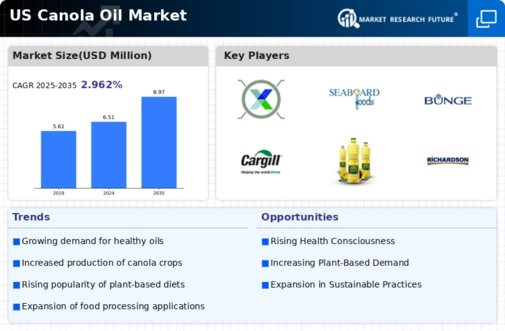Expansion of Food Processing Sector
The food processing sector in the US is expanding, which is positively impacting the canola oil market. As food manufacturers increasingly incorporate canola oil into their products due to its neutral flavor and high smoke point, the demand for this oil is likely to rise. In 2025, the food processing industry is projected to grow by approximately 3% annually, further driving the need for canola oil as a key ingredient. This growth is indicative of a broader trend where food processors are seeking healthier and more versatile oils to meet consumer preferences. Consequently, the canola oil market stands to gain from this expansion, as food manufacturers prioritize oils that align with health trends and consumer demands.
Rising Popularity of Plant-Based Diets
The canola oil market is witnessing a surge in interest due to the rising popularity of plant-based diets. As more consumers adopt vegetarian and vegan lifestyles, the demand for plant-derived cooking oils, including canola oil, is expected to increase. This trend is supported by data indicating that plant-based food sales have grown by over 25% in recent years. Canola oil, being a plant-based product, aligns well with the dietary preferences of this demographic. Additionally, the oil's versatility in various culinary applications makes it a preferred choice for those seeking to replace animal fats. As the plant-based movement continues to gain traction, the canola oil market is likely to experience sustained growth, driven by the evolving dietary habits of consumers.
Innovations in Packaging and Distribution
Innovations in packaging and distribution are playing a pivotal role in shaping the canola oil market. As consumer preferences evolve, companies are exploring new packaging solutions that enhance convenience and sustainability. For instance, the introduction of eco-friendly packaging options is becoming more prevalent, appealing to environmentally conscious consumers. Additionally, advancements in distribution channels, such as e-commerce, are facilitating easier access to canola oil products. This trend is particularly relevant as online grocery shopping continues to gain popularity. By adapting to these changes, the canola oil market can better meet consumer demands and improve market penetration. The combination of innovative packaging and efficient distribution strategies is likely to bolster the growth of the canola oil market in the coming years.
Sustainability and Environmental Concerns
Sustainability is becoming a critical factor influencing consumer choices, and the canola oil market is not exempt from this trend. As consumers increasingly prioritize environmentally friendly products, the demand for sustainably sourced canola oil is likely to rise. The oil is often produced using practices that minimize environmental impact, such as reduced pesticide use and crop rotation. Furthermore, the canola oil market is responding to these concerns by promoting sustainable farming practices and certifications. This shift towards sustainability is expected to resonate with eco-conscious consumers, potentially leading to increased market share for canola oil. As awareness of environmental issues continues to grow, the canola oil market may find new opportunities for expansion and differentiation.
Increasing Demand for Healthy Cooking Oils
The canola oil market is experiencing a notable increase in demand as consumers become more health-conscious. This shift is largely attributed to the oil's favorable fatty acid profile, which is low in saturated fats and high in monounsaturated fats. According to recent data, canola oil accounts for approximately 20% of the total cooking oil consumption in the US. As more individuals seek healthier alternatives for cooking and food preparation, the canola oil market is likely to benefit from this trend. Furthermore, the growing awareness of the health benefits associated with canola oil, such as its potential to lower cholesterol levels, is driving its popularity among consumers. This increasing demand is expected to propel the market forward, creating opportunities for producers and suppliers within the canola oil market.


















Leave a Comment